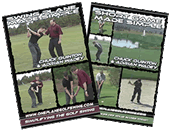Full Swing
Rotary Swing Tour - Anatomical Absolutes of Golf
Rotary Golf Learning Series
Golf Biomechanics Home Page
1. RST Overview
2. Use of the Hips and Core - Driver Swing
3. Biomechanically Correct Golf Setup and Balance
4. Functional Squat and One Legged Exercises
5. Functional Bridge Exercises
6. Inner Thigh/Hip Exercise
7. Back Stabilizer Exercise
8. Push vs. Pull
9. Golf Core Rotation Exercises
10. Golf Swing Weight Shift - Part 1
11. Golf Swing Weight Shift - To the Right - Part 2
12. Golf Swing Weight Shift - To the Left - Part 3
13. Sean O'Hair - Rotary Swing Tour
14. Common Swing Faults Caused by Setup
15. The Takeaway in the Golf Swing
16. Understanding Shoulder Elevation
17. The Role of the Right Arm in the Takeaway
18. Posture's Affect on the Takeaway
19. Golf Instruction - Muscle Activation
20. Tiger Woods Biomechanics
21. Move 2 - Completing the Backswing
22. Move 3 - The Golf Downswing
23. Creating a Golf Swing Plane
24. Effects of Bad Ball Position
25. 9 to 3 Drill
26. Move 4 - The Follow Through
27. Common Faults in the Follow Through
28. Tiger Woods - Getting Stuck - Downswing
29. Throw the Ball Drill
30. Right Arm Only - Downswing Drill
Rotary Swing Fundamentals
1. Golf Swing Fundamentals Home
2. Athletic Address Position
3. Body Movement
4. The Arms in the Golf Swing
5. Golf Spine Angle
6. Golfswing Takeaway
7. Proper Golf Grip
8. Golf Swing Rhythm Drill
9. Starting the Swing
10. Proper Divot
11.Forearm/Shaft Alignment
12. Head Behind the Ball
13. Golf Swing Wrist Hinge & Cock
14. Hip Turn
15. Hip Rotation Through Impact
16. Takeaway Chin Line
17. Passive Arms in the Golf Swing
18. Biomechanically Shorten Backswing
19. Rotation vs. Tilting Shoulders
20. Golf Swing Transition Bump
Rotary Golf Swing Drills
1. Golf Swing Drills Home
2. Body Drill
3. Impact Bag
4. Divots Left Tee Drill
5. Golf Baseball Swings
6. Broom Drill
7. One Leg Drill
8. Headcover Drill
9. Foam Roller Drill
10. Ben Hogan Pane of Glass
11. Shaft Plane Drill
12. Slide the Shaft Drill
13. 9 o'clock Swing Plane
14. Rotary Drill
15. Penetrating Flight Drill
16. In to Out Tee Drill
17. Neck Tie Drill
18. Bucket Drill for Synchronization
19. Lag Drill - Improve Your Golf Swing
Faults and Fixes
1. Faults & Fixes Home
2. Understanding Your Misses
3. Fixing a Hook
4. Fixing a Slice
5. Hitting Fat
6. Hitting Thin
7. Shots off the Toe
8. Shots off the Heel - Shanking
9. Left Side Breakdown
10. Pulled Shots - Student Analysis
11. Slicing
12. Coming Too Far From the Inside
Advanced Technique
1. Advanced Technique Home
2. Impact vs Address
3. Fade vs Draw
4. Hitting a Draw
5. Hitting a Fade
6. Hit It Low
7. Hit It High
8. Tiger Woods 2 Iron Stinger
9. Driver off the Deck
10. The Three Releases
11. Pinky Grip
12. Arms vs Body Release
Rotary Hitter
1. Rotary Hitter Intro
2. Impact Position
3. Chip Stroke
4. Hitter Backswing
5. Shoulder Turn and Right Arm Throwing Motion
6. Hitter Takeaway
7. Hitter vs Swinger
8. Right Hand Pressure Point w/ the Pure Ball Striker
Two Plane
Golf Impact Video Series
Short Game
1. Swinging Over the Top
2. Flat Left Wrist
3. Driver vs. Irons at Impact
4. Impact Fix Drill
5. Importance of Proper Grip
Bomb Your Driver Series
1. Bomb Your Driver Home Page
2. Ball Speed
3. Clubface Roll
4. Driver Sweetspot
5. Optimum Ball Launch Angle
6. Driver Golf Ball Spin Rate
7. Increase Clubhead Speed with More Lag!
8. Tiger Woods Most Inefficient Driver on PGA Tour
9. Driver Head Center of Gravity Design
Performance Putting Series
Putting
Mental Game
1. Forearm Shaft Alignment
2. Putting Distance Control
3. Putting Shaft Drill
4. Putting Acceleration Drill
5. Putting Hand Dominance
6. Face Angle in the Putting Stroke
7. Pendulum Putting Stroke
8. Putting Fitting - Shaft Length and Setup
Wedge Play
Mushin Golf
Golf Instruction
1. Mental Game Home
2. Introduction
3. Taking it to the Course
4. 10 Mental Principals
5. Confidence
6. You Are An Athlete
7. Spring Golf
8. Ultimate Destroyer
9. How To Practice
10. Developing a Mental Putting Routine
Course Management
1. Rotary Swing Golf Academy
2. In Person w/ Chuck Quinton
3. Driver Fittings
4. Demo Matrix Shafts and Nakashima Heads
5. Online Golf Lessons
6. Flightscope Kudu Launch Monitor at RSGA
Golf Equipment
1. Properly Fit Shafts
2. 2006 Golf Ball Review
3. Using a Launch Monitor
4. Sandwedge Bounce Angle
5. Flightscope Kudu Launch Monitor at RSGA
6. Demo a Matrix Driver Shaft!
7. Eyeline Golf Putting Plane
Professional Swings
Pro Golf Swing Sequences Home
Ben Hogan
Member's Swings
Golf Fitness
1. Ben Hogan's Swing
2. Ben Hogan's Shoulder Plane
3. Ben Hogan's Swing Face On
4. Ben Hogan's Swing Down the Line5. Ben Hogan - Reverse Pivot?
6. Ben Hogan's Address Position
Tiger Woods
1. Tiger Woods Swing Dynamics
2. Tiger Woods New Swing with Hank Haney
3. Tiger Woods Address
4. Tiger Woods Takeaway
5. Tiger Woods Backswing
6. Tiger Woods Downswing & Impact
7. Tiger Woods Most Inefficient Driver on PGA Tour
Chuck Quinton
1. Quinton 6 Iron Down the Line
2. 6 Iron Face On
3. Driver Face On
4. Driver Down the Line
5. Chuck Quinton DTL Analysis
6. Quinton Face On Swing Analysis
7. TaylorMade Performance Lab
Paul Dickinson
Stuart Appleby
Ernie Els Golf Swing DTL
Ernie Els Grip
Jose Maria Olazabal
Annika Sorenstam
Peter Jacobsen
Sam Snead
Adrian Wadey Face On
Adrian Wadey Down the Line
Tyler Aldridge 2007 PGA Tour Qualifying School
1. Golf Fitness Exercises
2. Hitting with Your Core
3. Balance on Swiss Ball
4. Golf Fitness Bridge Exercise
5. Stretching the Core
6. Advanced Leg Exercises
7. Intermediate Let Exercises
8. Losing Spine Angle in Golf Swing
Membership Info
Golf Tips & Info
1. One Plane vs. Two Plane Swing
2. One Plane Swing in Depth
3. Model Golf vs. One Plane
4. My Swing Philosophy
5. List of One Plane/Rotary Swing Instructors
6. Golf Chat Live Transcript
7. Golf Blog
8. Analyzing Golf Ball Flight
9. Stop Casting the Club
10. Causes of a Slice
11. Core Performance Golf
12. Efficiency of Movement
13. Fred Couples Golf Swing
14. Releasing the Golf Club
15. Hank Haney's Swing with Tiger Woods
16. Iron Shaft Survey
17. Key Components to Hardy's Swing
18. Losing Spine Angle
19. Mixing One and Two Plane Swing Fundamentals
20. Mushin Golf
21. Passive vs. Active Arms
22. Problem with Jim Hardy's Swing
23. Secret of Clubhead Lag
24. Right Arm in Golf Swing
25. Stuart Appleby's Golf Swing Video
26. Clubface Angle Video
27. Tiger Woods New Swing
by Chuck Quinton
![]()
With the Putting Plane System you can easily use the mirrored surface to check that your eyes are over the ball, shoulders are lined up, and putter face is square. Its adjustable rails fit any putter size, and the whole system conveniently fits in your bag.
The inside rail is slanted at 72 degrees; this allows the putter to come slightly inside as it moves back and up during the stroke. Your shoulders and arms can move along the plane. This allows them to move around your spine as one piece. The putter face naturally opens and closes along the plane as a stroke is made.
As the putter glides along the 18 degree rail, feel the perfect Up & Inside stroke.
Feel, See, and Repeat the perfect stroke...You will have never rolled it so well.
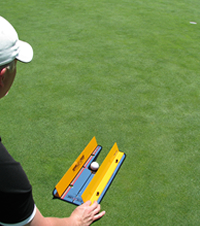 Step 1 - Precision Alignment to target line
Step 1 - Precision Alignment to target line
The first step in using the Eyeline putting plane is to accurately align it to your target.
Step behind the EyeLine putting plane and aim the center black line exactly at the target. The smaller your target, the more accurate your alignment will be.
Take your stance over the ball.
Don't be surprised if your eyes try to tell you your line is off.
You may have been seeing incorrectly for years!
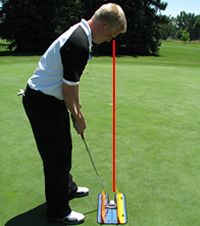 Step 2 - Eyes over the ball
Step 2 - Eyes over the ball
Look down at the ball.
Your eyes should be directly over the ball and the centerline.
This could take some adjustment in:
- -Your posture
- -The position of your hands at address
- -Your distance from the ball.
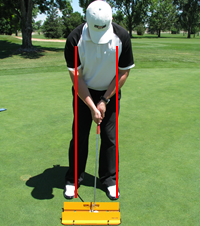 Step 3 - Shoulders square to target line
Step 3 - Shoulders square to target line
Since the putting motion is a rocking of the arms and shoulders, the shoulders need to be lined up to the target.
Look at the bottom of the EyeLine putting plane nearest your feet. You should be able to see the tops of both shoulders.
If you see only your back shoulder, you are open to the target line. If you see only your front shoulder, you are closed to the line.
Watch your shoulders as you make a stroke. Are they moving back and forth down the line?
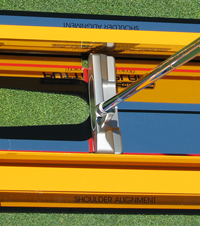 Step 4 - Square putter face to target
Step 4 - Square putter face to target
Square your putter face to the target line.
Use the red line directly behind the ball as your reference. You should be able to see the red line directly in front of the putter blade.
Step 5 - Accelerating Stroke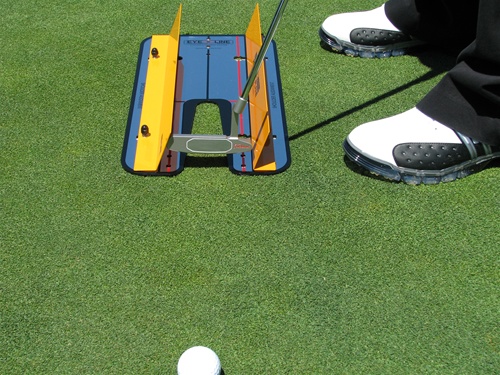
"There are two things you must do to start the ball on line: You have to keep the putter moving directly down the target line, and you must maintain a square clubface. The way to do those things is to ensure that the putter is gaining speed as it strikes the ball, rather than decelerating."
David Gossett
Golf Digest, Pg. 123, April 2002
All good putters have an accelerating stroke.
Good touch on the greens demands a stroke that is accelerating through the ball.
The EyeLine putting plane system was created to help with this good habit. There are holes behind the slot for the ball. When you place a tee in one of the holes, it provides a restriction to your back swing and forces you to accelerate through the ball.
Try this drill:
- Set up 10 feet from the hole.
- Place a tee in the EyeLine putting plane in the last hole behind the ball. Let the tee restrict your stroke and force you to accelerate. Stroke several putts trying to hit the ball farther each time. Move the tee to the next closest hole, and continue until the tee is in the closest hole to the ball.
- Get the feel of accelerating through the ball. Remove the tee and hit more putts.
- Notice how solidly you are striking the putts?
Note: This is a drill to help you learn to accelerate. As you do this drill, pay attention to the change in direction of the putter. A smooth transition combined with an accelerating stroke is Gold!
The Putting Plane Alignment System will improve your putting! Guaranteed.
|
|
|
| ||||||||

